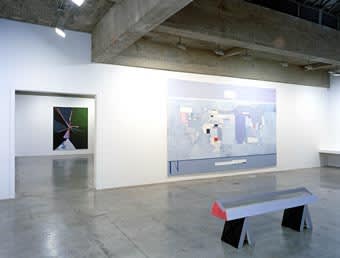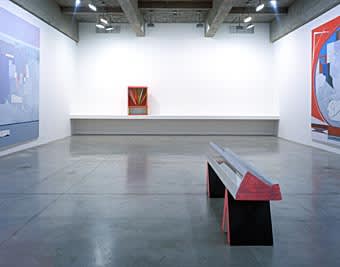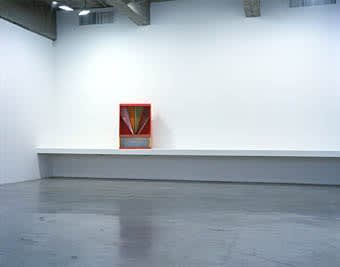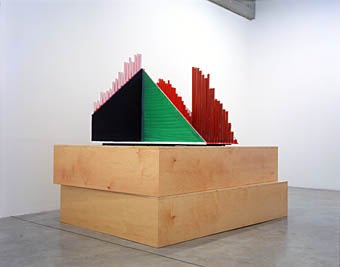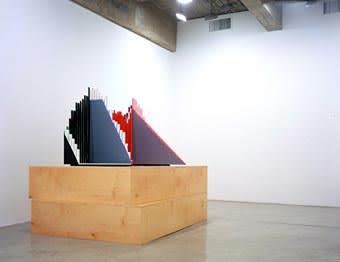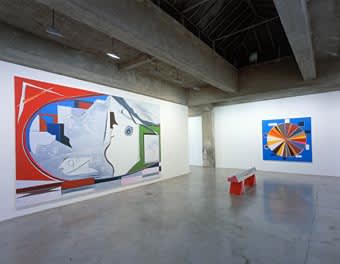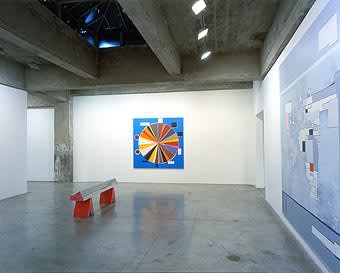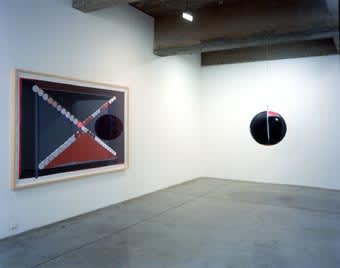Tanya Bonakdar Gallery is very pleased to announce the gallery's fourth solo exhibition with Thomas Scheibitz. Titled 'Brot und Spiele', the show features new paintings, sculpture and works on paper, all of which reinforce Scheibitz's skillful abstraction of images culled from the collective consciousness then pared down and layered in a precise balance of color and form. Constructing a delicate narrative of compositions derived from maps, statistical charts, advertising logos and selected generic subjects, Scheibitz continues his investigation of man’s ability to read, understand and recognize information and images.
Serving as the show’s centerpieces, two large-scale paintings derived from world maps resonate with their opposing conceptions of imagery and modes of representation. Old Map uses the first cartographic effort to reference America, the Waldseemüller-Map dating from 1507, to generate a stunningly dynamic abstract composition. Its counterpart, New Map, is developed from a 1970s statistical rendering of the world based on predicted population levels. Both maps show the nations of the world in strikingly different ways. In their presentation of information that is either incomplete or skewed towards specific data, the map provides Scheibitz with an ideal vehicle to explore the language of abstraction and the edge of visual communication. Together with these paintings, the main gallery also features Sundial, a multicolored painted wheel that seems simultaneously an illustration of a method of marking time and a graphic representation of a twisted carnival ride.
Scheibitz's anti-hierarchical practice incorporates painting and sculpture as equals: one becomes both the extension and representation of the other. In the main gallery, the sculpture Shell perches on a low shelf running the length of a wall, a strangely familiar emblem in ultra-bright red and gold. Also located here is Bank, a low-lying white rectangular form that plays on the linguistic relationship between English and German, and the terms for a type of seat and a financial institution. Statistic, in the small gallery, is a three-dimensional elaboration of the quintessential textbook bar graph; here the vertical rows of multicolored bars set at varying angles take on the semblance of a cartoon-city skyline. Similarly, the painting Game is a geometric, graphic composition but one that seems to be based upon a floor plan for a stadium, or an arena’s seating chart.
The crux of Scheibitz's work lies in the slippage of meaning, the play of signifier and signified, and the shift from literal to figurative and back again, all of which occurs among the layers of paint, between planes of mdf, and from one alternately bold or murky color to the next. The viewer is given but a thread to unravel their own associations and assumptions. Here, an underlying narrative can be better understood in the context of the show's title. Significantly, the title makes reference to the first century A.D. reign of megalomaniac Emperor Nero, who once remarked that 'bread and circuses' (Brot und Spiele in German) are the only way to manage a nation, and infamously presided over the destruction of the great city of Rome.
Thomas Scheibitz will represent Germany at the 2005 Venice Biennale, together with Tino Sehgal. Later in September, Scheibitz will be featured as an invited artist to the 26th Bienal de São Paulo. In October, the first major catalogue of Scheibitz's sculpture will be published by Walter König Books, following from his major exhibition of sculpture presented last Spring at the Centre d'Art Contemporain in Geneva, titled ABC - I II III. Other major solo shows include Bannister Diamond, Stedelijk Museum, Amsterdam; Ansicht und Plan von Toledo, Kunstmuseum Winterthur and Museum der Bildenden Künste, Leipzig; i95 Matrix, UC Berkeley Art Museum; and Low Sweetie, Institute of Contemporary Art, London. Major group exhibitions include Pittura / Painting: From Rauschenberg to Murakami, 1964-2003, Museo Correr, 50th Venice Biennale; Painting Pictures at the Kunstmuseum Wolfsburg; and Painting at the Edge of the World, Walker Art Center, Minneapolis.
